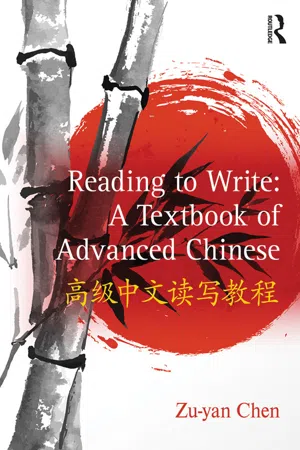
This is a test
- 146 pages
- English
- ePUB (mobile friendly)
- Available on iOS & Android
eBook - ePub
Reading to Write: A Textbook of Advanced Chinese
Book details
Book preview
Table of contents
Citations
About This Book
Traditionally, reading and writing are believed to be separate but related language processes and teachers follow the conventional wisdom of teaching in-depth reading, with writing as a tag-on issue.
Therefore, there exists an increasingly urgent call for a well-rounded reading-writing curriculum and a theoretically-informed, empirically-based, student-centered advanced textbook that aims to develop the synergy between reading and writing. Reading to Write: A Textbook of Advanced Chinese is intended to fill this significant gap. It treats reading and writing as integrative parts and interactive skills in Chinese language teaching, putting them hand-in-hand, supplementing each other.
Frequently asked questions
At the moment all of our mobile-responsive ePub books are available to download via the app. Most of our PDFs are also available to download and we're working on making the final remaining ones downloadable now. Learn more here.
Both plans give you full access to the library and all of Perlego’s features. The only differences are the price and subscription period: With the annual plan you’ll save around 30% compared to 12 months on the monthly plan.
We are an online textbook subscription service, where you can get access to an entire online library for less than the price of a single book per month. With over 1 million books across 1000+ topics, we’ve got you covered! Learn more here.
Look out for the read-aloud symbol on your next book to see if you can listen to it. The read-aloud tool reads text aloud for you, highlighting the text as it is being read. You can pause it, speed it up and slow it down. Learn more here.
Yes, you can access Reading to Write: A Textbook of Advanced Chinese by Zu-yan Chen in PDF and/or ePUB format, as well as other popular books in Filología & Idiomas. We have over one million books available in our catalogue for you to explore.
1 第一课 Writing about events, part one
记事篇上
1.1 Writing guide 写作指导
Key elements of event writing 记事要素
记叙文有六个要素:时间、地点、人物、事件的起因、经过和结果。
一个事件总是在一定的时段中发生、发展和变化。比如,上午、下午、晚上是一天的时段;上课前、上课时、下课后是一节课的时段;童年、少年、青年是人生的时段。以时间为序,组织材料,叫顺叙。用顺叙的法子,可以把事件的起因、经过和结果交代得很清楚。有时也可用倒叙,使文章结构富于变化,造成悬念,引人入胜。
不管用哪种法子,文笔一定要生动。此外,要通过对事件的叙述和描写,直接或间接地表达作者的思想。
Narratives have six key elements: time, place, character, as well as an event’s cause, progression, and result.
An event always occurs, develops, and changes within a certain time frame. For example, morning, afternoon, and night are time periods within a day; before class begins, during class, and after class ends are class time periods; childhood, adolescence, and young adulthood are stages of life. Organizing material in order of the time of occurrence is called narrating in chronological order. By implementing this method of recounting events in chronological order, it’s possible to account for cause, progression, and result very clearly. Sometimes one may also use flashback, which makes a composition even richer in structural change in addition to causing suspense and leading the reader to find the piece more interesting.
Regardless of which type of method is used, the style of writing must be lively. Furthermore, through the narration and description of an event, one must express the author’s thoughts directly or indirectly.
词汇一
| 1 | 指导 | 指導 | zhǐdǎo | instruction, guide |
| 2 | 记叙文 | 記敘文 | jìxùwén | narrative |
| 3 | 要素 | yàosù | key element | |
| 4 | 事件 | shìjiàn | event, incident | |
| 5 | 起因 | ... |
Table of contents
- Cover
- Half Title
- Title
- Copyright
- Contents
- Acknowledgements 鸣谢
- Preface 前言
- User’s guide 使用说明
- 1 Writing about events, part one: 记事篇上
- 2 Writing about events, part two: 记事篇下
- 3 Writing about people: 写人篇
- 4 Writing about scenery, part one: 绘景篇上
- 5 Writing about scenery, part two: 绘景篇下
- 6 Writing about feelings: 抒情篇
- 7 Persuasive writing: 议论篇
- Appendices 附录
- Vocabulary index 词汇索引